What Is A Crypto Bankruptcy Claim?
A crypto bankruptcy claim refers to the right of a creditor, such as a customer who lost funds when an exchange failed, to attempt collecting debt from the bankrupt company by receiving a portion of any recovered assets. The claim can then be sold to other parties.
Key Takeaways
-
Crypto bankruptcy claims allow creditors to potentially recoup losses by selling their claims to other parties, providing an alternative to waiting for bankruptcy proceedings to conclude.
-
Platforms are creating centralized marketplaces to increase liquidity and efficiency in claims trading, benefiting both claim holders and potential buyers.
-
Purchasing discounted claims represents a speculative opportunity, as investors can profit if assets are recovered at a higher rate than the purchase price.
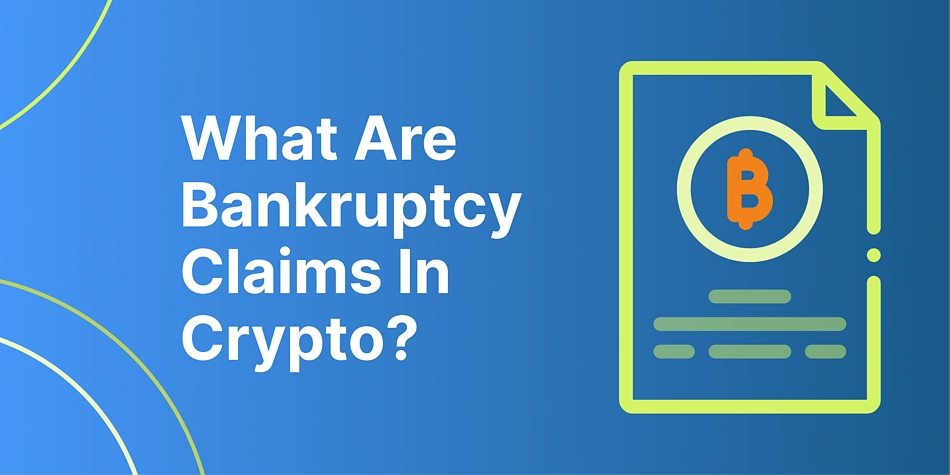
With the downfall of FTX in 2022, and the collapse of many custodians and exchanges that fell like dominos after, many customers lost all their funds deposited on the platforms. Now with some executives going on trial and receiving their punishments, duped customers are waiting for restitution and hoping to see their deposits returned after a long juridical battle.
While affected users may hope for the best, some have opted to prepare for the worst, leading to bankruptcy claims being traded both on and off exchanges. In this article, we’ll take a look at what they are, why they are important, and how you can get started with trading bankruptcy claims.
Understanding Crypto Bankruptcy Claims
A bankruptcy claim is nothing more than a mechanism that allows a creditor to transfer their right to collect on a debt to another person or entity. In the case of crypto, these claims will refer to specific cryptocurrency companies such as exchanges, custodians, and hedge funds that lost customer deposits or stakes by going bankrupt.
For example: User A had deposited crypto funds on Exchange B. When Exchange B declared bankruptcy, User A received a claim against Exchange B for the return of their deposited funds. User A can sell this claim to User/Company C, transferring their right to attempt collecting the lost funds from the bankrupt exchange.
Crypto is not introducing something completely new here. Bankruptcy claims have already existed long before the emergence of crypto and were also present in the notorious Bernie Madoff ponzi scheme bankruptcy scandal.
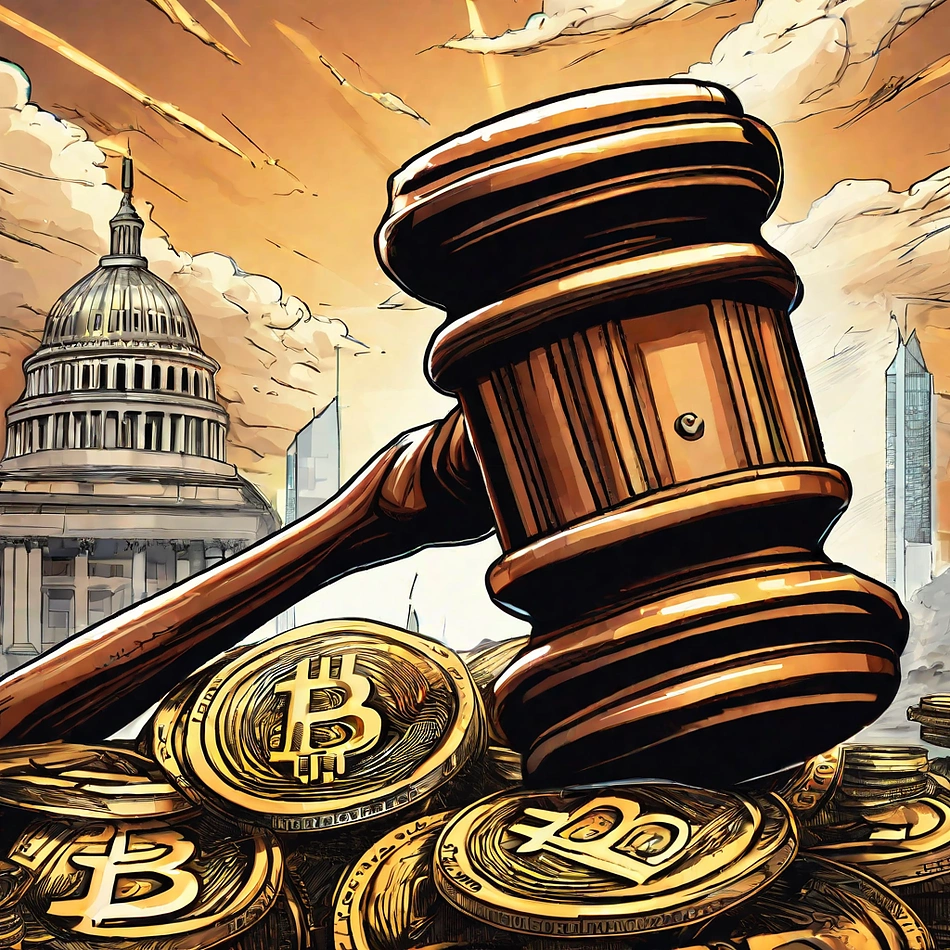
Source: Image generated using Midjourney
Why Do Bankruptcy Claims Even Matter?
While the short answer would be speculation, often claims markets are visited by (unsecured) creditors who want to eliminate the recovery risk, and choose a discounted but sure way out.
When a company goes bankrupt while holding customer funds, those customers can file a claim for their money. The court administrator then uncovers all the different assets held by the company, and pays back creditors based on their ownership and where they fall in the capital structure.
Let's consider an example where Exchange A declared bankruptcy with $10 billion in debts and $5 billion in remaining assets. In this simplistic case, claims on the assets would be distributed at 50 cents on the dollar to creditors ("claimants").
An investor spotted an opportunity and bought some claims worth $1,000 for only 30 cents on the dollar, costing $300. Now, if and when the assets are distributed, the investor receives $500 based on the 50 cents per dollar rate. This will result in a $200 profit ($500 received - $300 paid).
While this example was small, investors can deal with much larger bankruptcy claims valued in hundreds of millions. There is also potential for fuller recovery, allowing claims to be paid at up to 100 cents on the dollar for an even greater profit.
Some investors are buying these claims, essentially betting that the eventual payback will be worth more than what they paid for the claim. On the flip side, if creditors want money instead of promises for a brighter future, they can choose immediate cash and say goodbye to the stress that accompanies the lengthy process of bankruptcy cases.
Analysis Of Price Action Of Crypto Bankruptcy Claims


Source: Price Analysis by Wu Blockchain
With the current rising cryptocurrency prices, the market is pricing in a greater recovery, probably because there will be a greater chance that the assets still under the control of custodians and exchanges will be liquidated at higher prices than when they went bankrupt, helping to fill the gaps they left behind.
This is reflected in the pricing of the claims. According to Claims Market, claim pricing for FTX has reached a high of 57%. For Celsius, it's about 35-40%, and for Genesis at roughly 50%. Keep in mind these are exchanges and custodians.
In contrast, when we look at prices for funds and bankrupt market makers, we see that the market doesn’t have high hopes, with Alameda Research claims at 10-15%, and 3AC claims barely reaching 7-9%.
FTX Bankruptcy Claims
The most important and most traded claims are the ones of FTX. By analyzing these market movements, we can try to indicate the odds the market perceives for seeing the recovery of the once leading exchange and returning all funds back to its users.
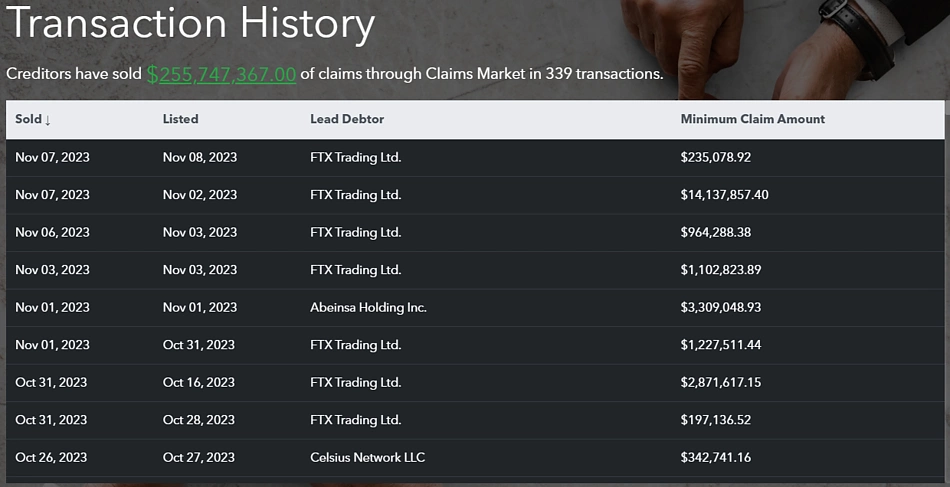
Source: Transaction History - Claims Market
Taking a look at FTX claims, we see the prices were increasing during the trial of former CEO Sam Bankman Fried, as buyers paid up for larger claims. FTX claims hitting 57% suggest beliefs in asset recoveries and mirrors confidence in a full recovery.
Amid these developments, there is also potential for a rebranding and launch of an "FTX 2.0." The trial and subsequent rebranding could provide a fresh start for the company, potentially restoring investor confidence and improving claim pricing over time.
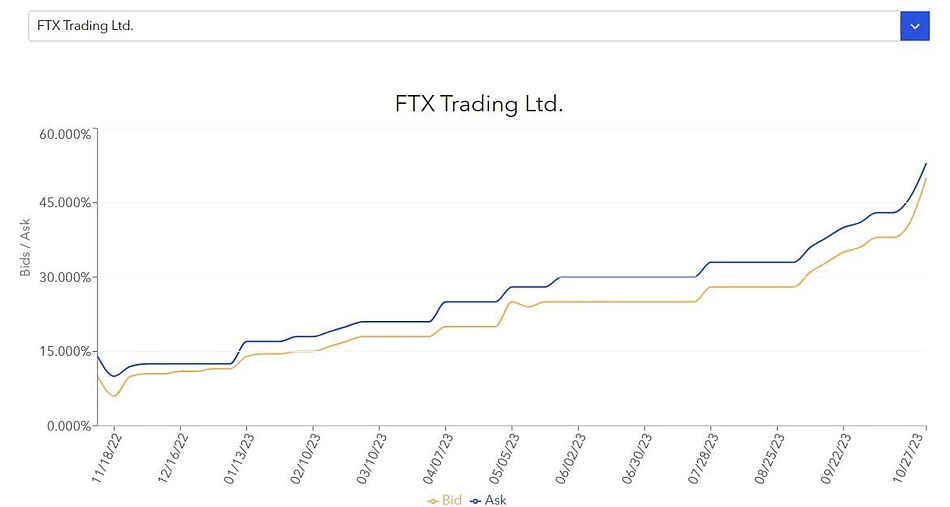
Source: Pricing Chart - Claims Market
Finding Crypto Bankruptcy Claims to Trade
Bankruptcy claims can be found in many ways. If you are a hedge fund, there is a chance that professionals who specialize in tracking down claims have already reached out to you.
But for most of us, this is not the case. So in order to take part in trading these crypto bankruptcy claims, we need to register on online markets where these claims are listed or can be tokenized. First, we’ll take a look at the biggest and most liquid claim market.
Claims Market: The Biggest Claim Market
Claims Market is an online platform that aims to streamline and simplify the process of buying and selling bankruptcy claims, with its focus not only on crypto companies but also on traditional companies as well.
This market does nothing more than bringing verified sellers and buyers together and letting them trade their claims through its transparent marketplace.
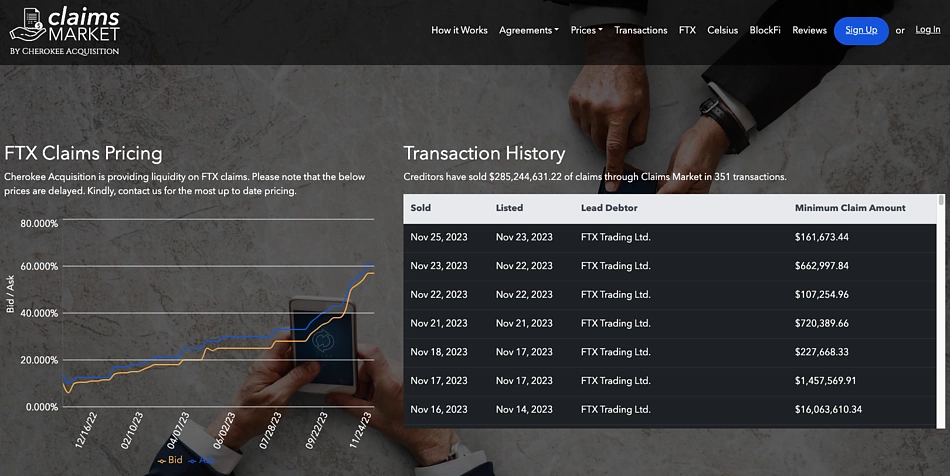
The choice of what bankruptcy claims you want to trade will be limited to the options available on the claims market. Looking at their offerings, we see many rekt companies where the debts are possible to trade, including: Alameda Research LLC, BlockFi Inc., Celsius Network LLC, FTX Trading Ltd. and Genesis Global Capital, LLC.


How Does Claims Market Work?
The process of the claims market is simple, as it works by having sellers list their bankruptcy claims for sale on their site and upload necessary documents. Once approved, the sellers can start asking for offers. This is where the platform curates all the offered claims and only lists allowed claims for sale.
When you have sellers on one side, you have the buyers on the other. Interested buyers also verify and accept the buyer's agreement. After this, they can browse through the listed claims and select the ones they want to bid on or purchase directly at the market or listed ask price.
You could say that there are many similarities with regular markets, with the only thing that differs being the trading products. In this case, instead of crypto assets, you trade bankruptcy claims that will give you the right to collect debt or deposits if compensation ever occurs.
Simple Assignment of Claim (SAC)
Claims Market uses a Simple Assignment of Claim, also known as a SAC agreement, that balances the interests of sellers and buyers.The SAC agreement formally and legally transfers bankruptcy claims between parties according to market standard terms and obligations of both seller and buyer throughout the claim life cycle.
Buyer's Agreement highlights:
- Buyers must do their own due diligence before purchasing claims.
- Buyers should not interfere with the listing rights of the Administrator.
- Any disputes are to be resolved through arbitration.
- The Administrator does not provide warranties about the listed claims or sellers.
Seller's Agreement highlights:
- Sellers must exclusively list their claims on the website for ten days.
- Sellers cannot communicate directly with potential buyers.
- Sellers must respond to counter-offers within one business day.
- Changes to the agreement or sales terms can be made via email.
- A buyer's agreement to the Purchase Rate finalizes the sale.
- Disputes are resolved via arbitration and the Administrator assumes no liability.
XClaim: The Most Simple and Straightforward Claim Market
Xclaim is also a centralized digital marketplace, which allows for the trading of bankruptcy claims and connects claimants and eager investors who want to buy. Since its inception, it has helped over 10,000 creditors manage more than $750 million worth of bankruptcy claims. Xclaim doesn't charge sellers a fee to register, list, sell, or transfer claims, and only charges buyers a fee.
On XClaim the choices for claims trading are limited to three options, namely; Celsius Network LLC, FTX Trading Ltd. and Genesis Global Capital, LLC.
How Does Xclaim Work?
Xclaim's process is very simple, as it takes the hassle out of claims trading. They handle all the required filings so claimants can do their business in the fastest way possible. To get started we follow the next steps:
- Sign Up: Create an account on the Xclaim Marketplace platform.
- List Your Claim: Provide the details of your bankruptcy claim. This typically includes the amount of the claim, the debtor's name, and the details of the bankruptcy case.
- Connect with Buyers: Interested buyers will be able to view your listing and make offers. You can then negotiate with potential buyers to agree on a price.
- Finalize the Sale: Once you've agreed on a price with a buyer, you can finalize the sale. The buyer will then pay you for the claim, and the ownership of the claim will be transferred to them.


Source: Xclaim Claims Submission
Open Exchange: Tokenize Your Crypto Bankruptcy Claims
Crypto wouldn't be crypto if everything weren't tokenized. The same applies to bankruptcy claims now being put on the blockchain via Open Exchange. This recently launched exchange, established by two well-known and controversial crypto figures, Su Zhu and Kyle Davies, presents itself as a tokenization solution provider. They manage the onboarding, verification, and tokenization of real-world assets (claims) for their OPNX users.
The choice of what bankruptcy claims varies on Open Exchange. Users can tokenize and convert bankruptcy claims including: Celsius (minimum of $2,000) and FTX claims (maximum $100,000). Later, the tokenization of BlockFi Inc., and Genesis Global Capital, LLC. Mt.Gox,, Hodlnaut, Vauld, Zipmex, Voyager and the founders own fund – Three Arrows Capital – will be possible.
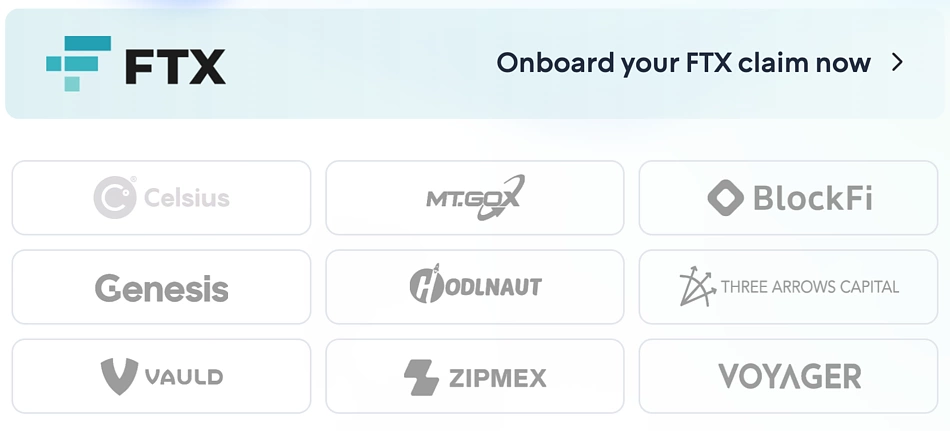
How Does Open Exchange Work?

Users of the exchange can tokenize and convert their claims. OPNX offers two distinct methods for unlocking value from claims – conversion into either reOX or oUSD. Each of these options has its own features and benefits.
reOX
- reOX stands for 'Reborn OX' and they are locked OX tokens that cannot be withdrawn from OPNX until the preference risk for a claim is settled.
- The amount of reOX allocated to a specific claim is roughly equal to the current value of the claim based on OTC price live-feeds from the Claims Market.
oUSD
- oUSD serves as the credit currency on the OPNX platform and provides a reliable, dollar-denominated collateral.
- Although oUSD is not directly pegged to the U.S. dollar, it maintains a close value correlation with it due to its redemption mechanics where oUSD can be swapped or redeemed for USDT.
Conclusion
The downfall of major crypto players left many customers without access to their funds and their hopes disappeared. But luckily a secondary market arises where all claimants and creditors can find a way to potentially recoup a part of their losses.
For investors, this can be a speculative investment where claims at low prices represent an opportunity. That is, if assets are ultimately recovered at a higher rate, or the bankrupt company rebounds, they stand to profit.
By creating centralized digital marketplaces, platforms like Claims Market, Xclaim, and Open Exchange aim to increase efficiency and liquidity in bankruptcy claims trading and connect claim holders with prospective buyers.

Hans entered the space in 2017 for the quick gains but ended up staying poor. Since 2020, he has contributed to many crypto projects and has written several blog posts in English and Dutch. By sharing his research and findings, he hopes that everyone reading can make better informed decisions.




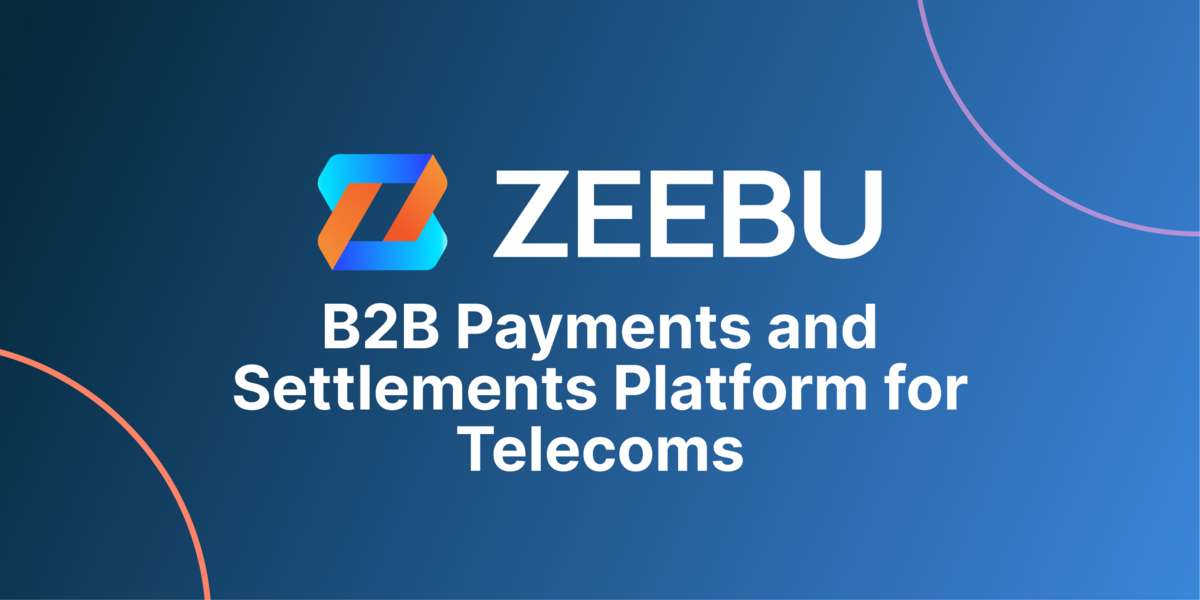




 Or check it out in the app stores
Or check it out in the app stores